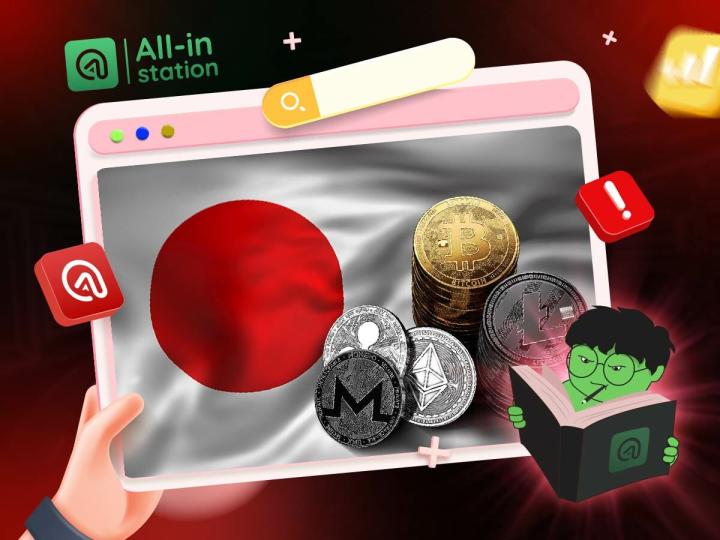This 162-page research report from Citigroup comprehensively explains the specific path for the blockchain and Web3 industry to achieve a billion users and a market size of tens of trillions of dollars. More importantly, this is not just empty talk. We may have already achieved 20% of the progress bar! To achieve a market of tens of trillions of dollars, it is far from enough to rely on the nearly 1 trillion dollars of crypto-native market that has been formed. Citigroup has given a broader dimension - Real World Assets Tokenization. The current nearly 1 trillion scale of the crypto-native market is already passionate. Imagine how magnificent the tens of trillions of dollars market would be!

Disruptive technologies often change the way people do things, such as how people live, work, consume, invest, socialize, and so on. Blockchain and the related Web3 concept are disruptive technologies. In the past few years, people have been talking about the potential of tokenization through blockchain and believe that it is transformative, but we have not yet reached the point of large-scale application. Unlike recent innovations such as new energy vehicles or ChatGPT or Metaverse, blockchain is a backend infrastructure technology with no prominent consumer interface, so it is difficult to see how it can innovate from the surface.
However, blockchain as a disruptive technology is different from many other technologies, first of all, it involves the transfer of value, and it enters the field of currency (which is a highly regulated field in most countries). Secondly, blockchain will not have a ChatGPT moment, because blockchain is a low-level infrastructure technology, more similar to cloud computing than artificial intelligence (AI) or Metaverse, which have more prominent consumer-oriented attributes. Therefore, although the blockchain revolution started in fringe countries, to promote its large-scale application, it needs the support of sovereign governments, regulated financial institutions and large companies, as well as the support of crypto-native rebels, because they are at the core of innovation, change and progress.
In this report, we will explore some of the key drivers that will enable the blockchain and Web3 industries to have the next billion users and potentially bring about tens of trillions of dollars in market economic activity, affecting every aspect of our lives and work.
1.1 Billions of Users

Billions of users will be added to the blockchain industry’s daily applications, including currency, games, social media, etc. Successful applications of blockchain technology will have more than 1 billion end users who don’t even realize they are using the technology.
Money : Some countries (with a total population of about 2 billion) may try central bank digital currencies (CBDCs) related to blockchain technology, especially CBDC projects that some mainstream countries will adopt, such as the digital euro (EUR), digital pound (GBP), and digital rupee (INR). These projects will roughly cover 1/4 of the world's population and monetary savings.
Game : The next generation of games will include tokenization of game assets, which will initially be driven by Asian games to attract high-end consumer users. The gaming industry will also drive most players into the blockchain, especially the Web3 gaming ecosystem in Southeast Asian countries.
Social Media : Micropayments, including payments in Metaverse games, are likely to use blockchain technology. In addition, large consumer brands are also promoting the application of Web3. Art collection, film and television, and music entertainment will also enter the blockchain industry based on the characteristics of blockchain (such as NFT), and there are many big brands such as Nike and Starbucks that are helping.
1.2 Trillions of Dollars
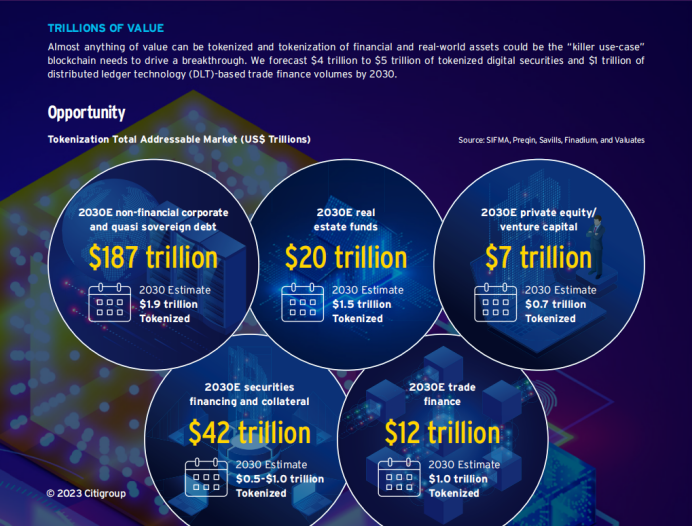
We estimate that by 2030, up to $5 trillion could be transferred to new forms of digital currency, such as CBDCs and stablecoins, of which about half could be based on blockchain distributed ledger technology. Benefiting from legal and technological innovations, the tokenization of real-world assets (RWA) will be the killer app that drives the blockchain industry into the tens of trillions of dollars. Almost any asset that can be represented by value can be tokenized, whether it is red wine or financial assets. We expect the tokenization of private sector/unlisted company assets to grow more than 80 times, reaching a scale of about $4 trillion by 2030.
By 2030, up to $1 trillion of assets in global trade finance could be tokenized. We expect private sector/unlisted companies such as securities and funds to drive up to $5 trillion in tokenized markets: non-financial corporate and quasi-sovereign debt markets; repo, securities financing and collateral markets; alternative asset markets such as real estate, private equity (PE) and venture capital (VC). Estimates of the total size of tokenization in the financial industry are even higher.
1.3 Technology and Legal Enablers
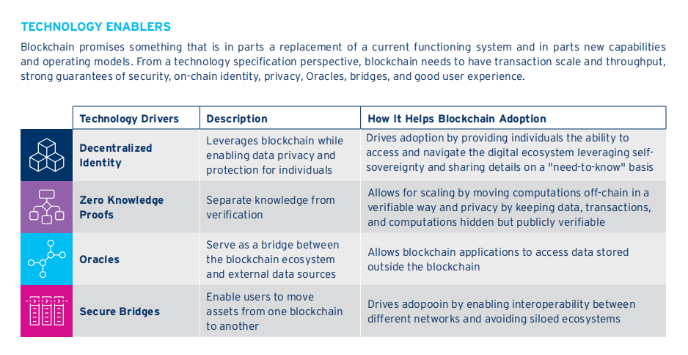
Bringing billions of users and trillions of dollars of assets into the blockchain and Web3 industry requires comprehensive improvements in technology and law to support and maintain the entire ecosystem. These changes may include blockchain-based identity solutions (Decentralized Digital Identities), privacy solutions supported by zero-knowledge proofs (Zero-Knowledge Proofs), solutions for connecting/providing off-chain real-world data (Oracle), and cross-chain technology solutions (Secure Bridges).
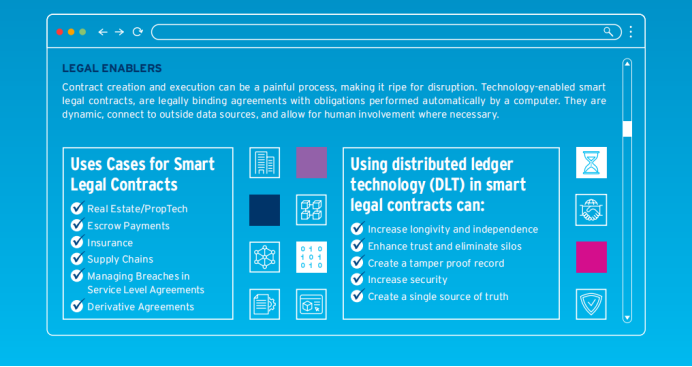
Of course, there is also a strong regulatory and legal framework that allows individuals and institutions to accept this new technology. The next generation of legal smart contracts (Smart Legal Contract, SLC) is on the way, and SLC will provide a new operating model for global business and finance.
 Web3, Tokenization, and Opportunity
Web3, Tokenization, and Opportunity
Web3 generally refers to the third iteration of the Internet, which is based on blockchain technology to achieve personal ownership and decentralization. The decentralized nature of Web3 can create a more transparent environment and help solve the ownership and data control issues from Web2 entities.
As we explain in this report, the key drivers of blockchain and Web3 adoption will be Web2 consumer companies and established traditional financial institutions. We believe that Web3 and Web2 will run in parallel and in some cases nested within each other, like a Russian Matryoshka.
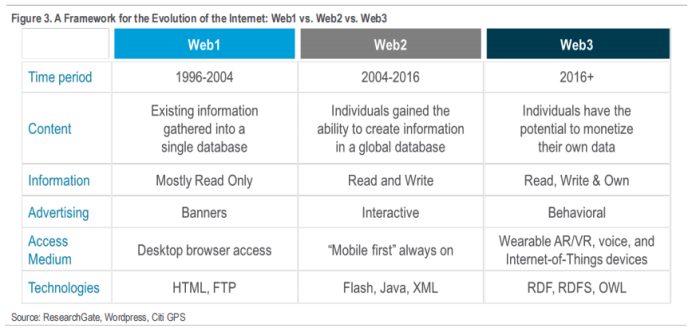
2.1 Definition of Tokenization
Tokens are snippets of code on a blockchain that record information about the liabilities of an underlying asset, including its properties or characteristics, status, transaction history, and ownership. Tokenized assets can be traded/transferred directly on the blockchain network to transfer their ownership and value. Asset tokenization can be divided into two categories:
A. Real World Assets : Represents highly illiquid, customized assets such as real estate, art and collectibles, agriculture, climate assets, and intangible assets (such as carbon credits and intellectual property). Real World Assets may also include financial assets that are not frequently or easily traded, such as trade invoices, private loans or mortgages, which are not generally defined as "securities".
B. Financial Assets : Assets that represent existing financial value, such as currency, stocks, bonds, commodities and funds.
In theory, almost any asset with monetary value can be tokenized. We believe that the best use cases for tokenization will be central bank digital currencies (CBDCs) and private sector/non-listed company assets (Private Financial Assets), especially illiquid assets, as well as in-game assets.
2.2 Tokenization opportunities
According to research by BCG and ADDX, the tokenization of global illiquid assets will generate a market of US$16 trillion (which will be close to 10% of global GDP in 2030), including a US$3 trillion housing asset market, a US$4 trillion listed/unlisted asset market, a US$1 trillion debt and investment fund market, a US$3 trillion alternative financial asset market, and a US$5 trillion market for tokenized other assets.
We believe that the private sector/unlisted company market is more suitable for blockchain applications due to the liquidity, transparency and fragmentation created by tokenization. For listed company securities across industries, tokenization will also provide benefits in areas such as efficiency, collateral use, data use and ESG tracking.
Although the industry is still in its early stages, based on our conversations with industry experts and insiders, we estimate that if 1% of corporate and quasi-sovereign bonds, 7.5% of real estate funds, 10% of private equity and venture capital funds, and $1 trillion in securities financing and collateral activities are tokenized, the market size of digital securities will reach $4 trillion to $5 trillion. Along with the tokenization of the trade finance market, by 2030, the blockchain-based trade finance market size may be as high as $1 trillion, accounting for about 8%-10% of the global trade finance scale.
To achieve the above goals, the support of traditional financial institutions will be needed, both in the tokenization of assets and in the promotion of relevant legislation.
2.3 Why is there a need for tokenization of real-world assets (RWA)?
RWA opens a new paradigm for monetizing illiquid assets, which helps to retain partial ownership of assets while releasing liquidity. For example, art collectors can tokenize their treasured collections, on the one hand, to share ownership with enthusiasts around the world, and on the other hand, to give their collections to museums for safekeeping and public display. In addition, tokenization can also provide new financing methods for infrastructure assets (such as roads, heavy machinery and public goods), and open up new direct decentralized financing channels for small companies and small and medium-sized enterprises (SMEs). Tokenization using blockchain technology can solve problems in traditional financing of sectors, such as lack of transparency, lack of liquidity and lack of democracy. Tokenization also helps to improve the efficiency of investors holding real assets on their balance sheets because it can provide liquidity for illiquid assets and simplify the mortgage process.
A. Real Estate : The traditional real estate market has been criticized for lack of transparency, difficulty in circulation, and numerous intermediaries. Blockchain can be a good choice, serving as a single, public source of information, providing data and coordination for all participants. Tokenization can also help reduce the minimum investment amount and potentially reprice assets.
B. Art and Collectibles : Tokenization of art and collectibles can help increase asset transparency, serve as proof of asset origin, provide liquidity, and offer ownership fragmentation (the ability to split portions of an asset to other investors).
C. Unconventional Commodities : From gold to agricultural products, more and more commodities are being brought onto the blockchain. Agriculture: Platforms like Agrotoken use Oracle and real-world food reserve proofs to create stablecoins backed by commodities such as soybeans, corn and wheat, providing new financing solutions. Climate finance projects: Blockchain can help with reliable records and carbon credit transfers between suppliers and demanders, while also lowering the entry barriers to carbon trading.
2.4 Challenges of Real World Assets on Chain (RWA)
The main obstacle to the scale-up of digital assets lies in the fragmented legal and regulatory environment for digital assets in different jurisdictions and the lack of unified classification or classification standards worldwide. In addition, the tokenization of real-world assets may also encounter other additional challenges:
- Interoperability Issues: Interoperability issues may arise when a token is based on multiple blockchains, or when a token needs to interact with backend systems outside of the blockchain ecosystem, and between new architectures built on different chains.
- Lack of Experienced Custodians : There are a limited number of professional third-party institutions that can safely custody tokens and real-world assets.
- Duplication and Unauthorized Tokenization : While information on blockchains is publicly visible, there is a lack of oversight and standards of practice to cut out duplication or unauthorized tokenization related to real-world assets.
- Real-World Liquidity Risks : On-chain liquidity is often greater than real-world liquidity, possibly due to market access with fragmented ownership.
- Elevated Cyber Risk : More technologies need to be developed to achieve transparency in blockchain without revealing the actual information of borrowers and asset owners. The most widely used privacy solution is zero-knowledge proof (ZKP). Cyber hacking attacks on blockchain will bring additional risks associated with the theft or loss of tokens.
- Difficulty of Full Disintermediation : Internet of Things (IoT) technologies and Oracle networks for valuation and status reporting of underlying real-world assets are still in their infancy and may take some time to reach large-scale commercialization. Until then, many key steps such as valuation, accounting, and reporting may still rely on human expertise and manual labor, just like traditional finance.
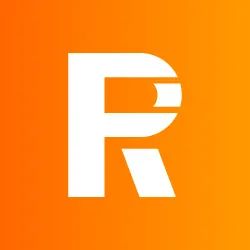 Billions of Users
Billions of Users
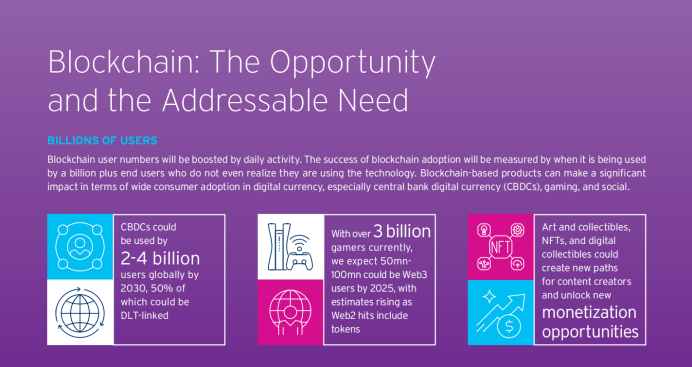
Blockchain-based currencies, games, and social products will have a significant impact on consumers. In this chapter, we will discuss how blockchain is revolutionizing these areas, why it is happening now, and how it will gain billions of users.
3.1 Central Bank Digital Currencies (CBDC)
CBDC is a digital currency issued by the central bank and denominated in the national currency unit, representing a form of liability of the central bank. This is different from other forms of digital payment instruments (such as card payments, electronic money, credit transfers), which are liabilities of private institutions.
Currently, more than 100 countries have conducted research, discussions, and experiments on CBDC, but only some small countries have adopted CBDC projects based on distributed ledger technology. Some large countries (with a total population of about 2 billion) may soon try central bank digital currencies (CBDCs) related to distributed ledger technology, such as the digital euro (EUR), digital pound (GBP), and digital rupee (INR). These projects will roughly cover 1/4 of the world's population and monetary savings. However, large countries such as China have adopted CBDC projects based on centralized ledger technology for policy reasons.
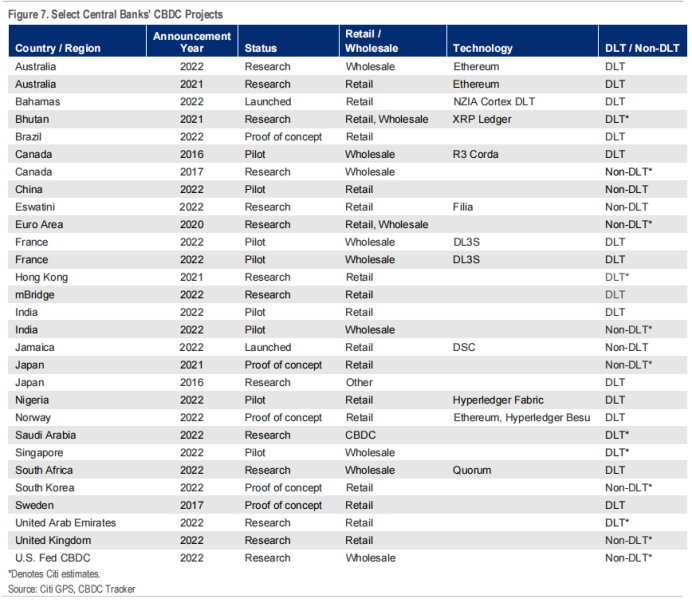
In addition to individual use cases for CBDC, millions of businesses and importers/exporters will use bilateral or multilateral CBDC settlement arrangements developed between different countries. For example, the distributed Multi-CBDC project between China, Hong Kong, Thailand and the UAE is piloting different use cases, starting with cross-border foreign exchange (FX) trade settlement.
The Bank of England expects that 20% of savings will be converted into digital currency, which means a digital currency circulation market of more than $5 trillion and 2 billion users, half of which are based on distributed ledger technology. Banks' currency reserves cannot be transferred, but they can be made highly liquid in the form of CBDC, which is convenient for banks' balance sheets and liquidity management.
In addition, the increase in CBDC projects may bring numerous stablecoin projects to the fore, as stablecoin projects can hold CBDC as their reserves, which is more stable and liquid than general money market instruments.
3.2 Gaming
Games may be one of the biggest entry points for consumers to enter the blockchain and Web3 industry from the bottom up. In 2022, more than 1 million independent active wallets were connected to game Dapps every day. With the emergence of Web3 games, especially blockchain games from Asian studios in the next 1-2 years, the most active players (nearly 100 million "whales") will turn to blockchain games. This may prompt mainstream game studios to add blockchain and tokenization elements to their games.
Games account for the largest share of the entertainment industry, with revenue exceeding that of the film and music industries combined. According to Newzoo, the gaming market is massive, with nearly 3.2 billion players by 2022. In 2022, $184 billion in gaming revenue will be generated, with Asian players contributing half, North American players 26%, and European players 18%. Even if only a small fraction of gamers use blockchain-based games, this increase is enough to leverage the entire blockchain and Web3 ecosystem.

In our opinion, the gaming industry is inherently suited to blockchain. Gamers are tech-savvy and most already have a good understanding of digital ownership and digital assets. The advent of Web3 and the rise of new economic models (Play to Earn) aim to allow players to own their own in-game assets. These digital assets can range from digital currencies to in-game assets that have been tokenized.
Until now, blockchain-based games have often been developed by crypto-natives who focus more on in-game token economics than on making the games fun and exciting. Hardcore gamers often criticize the shallow and simplistic gameplay in blockchain-based games. Some players also worry that NFTs and in-game tokens could become another tool to squeeze more money out of players.
The next generation of game developers are already working to integrate digital assets into fun games. This will help address current concerns in the gaming community and increase adoption. For example, the recent Dookey Dash competition hosted by Yuga Labs provided a fun gaming experience for the Bored Ape Yacht Club community, attracted participants from all over the world, and demonstrated the importance of NFTs in gaming.
We believe that the next iteration of blockchain-based games will include digital asset elements and more sophisticated models (not just Play to Earn). Conventional paid game models (Pay to Play) or free game models (Free to Play) will include blockchain elements, even without players' explicit perception (gamers will not understand the benefits of cloud computing to games, nor will they understand whether the game is based on Amazon Cloud Server or Google Cloud Server).
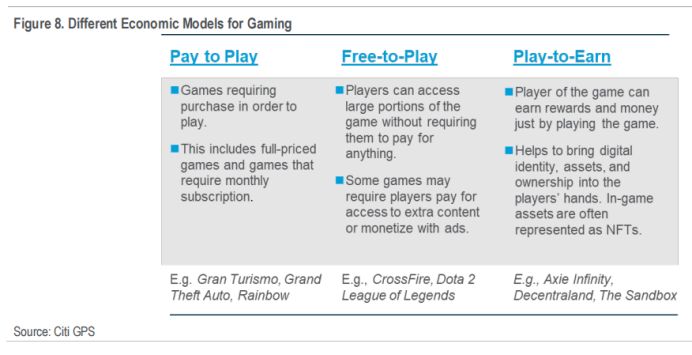
Today, there are over 3 billion gamers worldwide, and by 2025, we may see close to 50-100 million people using games with Web3 or blockchain elements. Gamers in Asia are likely to be the earliest adopters. However, the reality is that a small group of gamers accounts for the majority of gaming spending. In the coming years, we may see a major shift in transaction spending from off-chain to on-chain. The shift of heavy consumers to blockchain games could be an inflection point for the entire Web3 gaming ecosystem.
3.3 Social Media
Web3 supporters believe that a completely decentralized new system needs to be established. Blockchain-based social media can help with identity verification and account verification, and the process is completely open and transparent. The publicly shared, tamper-proof digital transaction ledger created by the blockchain can also help users improve the credibility of transactions and help build trust.
Companies like Aave are building decentralized social media platforms like Lens Protocol, where users can create profiles on the chain, follow others, create and collect content, and the ownership and control of the content remains in the hands of the users (Social Capital), and users can also tokenize it. This is different from the Web2 era where user data is locked in a platform, monopolized by the platform and used for free.
The emergence of the Web3 creator economy enables users to take ownership of their own content. Web2 companies are also taking action, with the Raddit social media forum enabling millions of users to enter Web3 through their NFTs. Consumer and fashion brands such as Adidas, Nike, Burberry, and Gucci are embracing NFTs and in-game assets in an attempt to catch up with the next big cultural and marketing trend. Amazon plans to launch an NFT marketplace for its 167 million Prime users in the United States in April 2023, and the move may be global thereafter.
We believe that the current market size of the creator economy is 60 billion/year, and it is growing at an annual rate of 9%. By 2024, the market size will reach 75 billion, and many sub-segments are growing at double-digit rates. Blockchain-based social media platforms aim to put social media on the chain, providing the advantages of privacy protection, personal data ownership, and control over generated content. Most platforms also provide native tokens for tokenization of creator content. However, decentralized social media networks are still in their infancy, and the user experience is not as rich as traditional media.
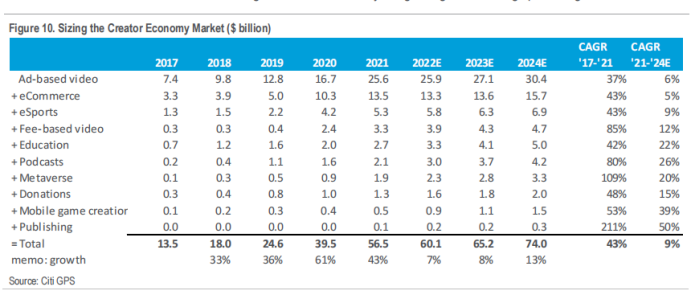
3.4 Art, NFTs, and The Metaverse
Trust is the most important factor in the art world. Blockchain technology can help solve the trust problem without forcing anyone to trust a particular person or institution. Tokenization of artworks can help embed due diligence certificates in smart contracts through cryptographic verification and store them on-chain, making this information accessible to everyone.
The art market is plagued by fraud, forgery, and theft. Without any central authority, it can be difficult to establish a trustworthy registry of digital records. Using blockchain technology does not mean that traditional market participants cannot be trusted. Instead, it shows that they are more trustworthy because all information will be recorded on an immutable ledger.
Blockchain technology can help create immutable records of ownership history, independent valuation records, and ownership certification throughout the life cycle of artworks. These proof records, also known as asset tokens, can be bound by law and are digital representations of proof of ownership. We can see that art owners and traditional galleries, such as Sotheby's, Christie's, and Phillips, are working with blockchain companies to create digital proofs that capture all information related to artworks.
In addition, digital proof of artworks can also be packaged in token assets to create institutional-level investment opportunities for high-value artworks and collectibles. Blockchain-based art funds can create an open and transparent environment for potential investors by providing artwork data, attribute performance and update records. For example, Sygnum, a Swiss digital asset bank, tokenized Picasso's Fillette au béret work itself according to the Swiss digital asset legal framework, enabling individual/institutional investors to participate in the investment of the work's Art Security Tokens.

As an emerging art form, NFT has been highly sought after in 2021. According to data from Nonfungible.com, between March 2022 and February 2023, there were 3.8 million sales transactions of artworks and collectibles, with a value of US$9.5 billion. In the real world, artists cannot get a share of the revenue from secondary sales, but NFT can ensure that artists can obtain subsequent secondary sales royalties after the initial minting sales through careful design.
In addition to artworks, collectibles can also be put on the chain in the form of NFTs. In addition, NFTs can serve as proof of authenticity of the corresponding physical assets, creating trust, especially in the high-end collectibles market. For example, the BlockBar platform enables luxury brands to issue NFTs for their collections of wines and rare spirits. The main goal is to own exclusive wine and spirits bottles on the one hand, and to trade them on the secondary market on the other hand, while the physical bottles are kept in a secure, temperature-controlled warehouse.
Consumer goods, luxury goods, and fashion brands are keen on NFTs, which could attract 1 billion users. Various brands, especially Starbucks, Nike, Disney, etc., are trying to use NFTs to increase customer loyalty, engagement, and marketing. E-commerce platform Shopify launched a Web3 toolkit that enables merchants to easily create Web3 business experiences.
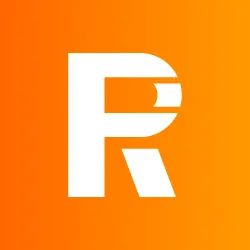 Trillions of Dollars
Trillions of Dollars
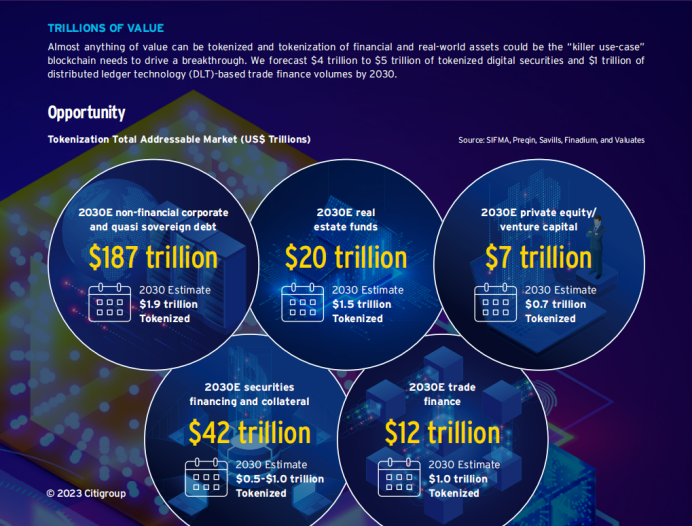
4.1 Tokenization of the Securities Market
Why are securities markets important? Because the global market for outstanding equities and fixed income exceeds $250 trillion. Therefore, traditional securities markets have the potential to be one of the largest use cases for tokenization. We believe that the private company/unlisted enterprise market may be tokenized faster due to the many benefits it brings, such as high liquidity, public transparency, and ownership fragmentation.
Although the industry is still in its early stages, based on our conversations with industry experts and insiders, we estimate that if 1% of corporate and quasi-sovereign bonds, 7.5% of real estate funds, 10% of private equity and venture capital funds, and $1 trillion in securities financing and collateral activities are tokenized, the digital securities market will reach $4 trillion to $5 trillion. At the same time, the tokenization of the trade finance market will also be accompanied. By 2030, the scale of trade finance based on blockchain technology may be as high as $1 trillion, accounting for about 8%-10% of the global trade finance scale.
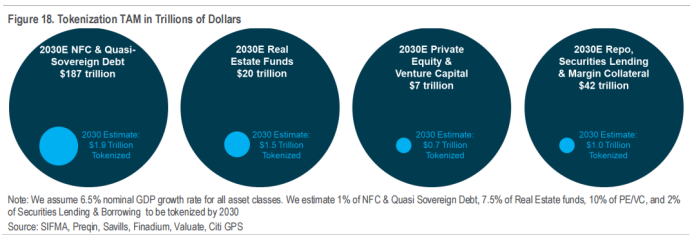
4.2 Why does the securities market need tokenization?
So why do securities market products such as stocks, bonds, and funds need to be tokenized? The traditional securities market has already solved the problems of accessibility, high liquidity, and openness and transparency for most products. What is the driving force behind private equity giants (such as KKR, Apollo, and Hamilton Lane) to set up their crypto funds on digital asset exchanges such as Securitize, Provenance Blockchain, and ADDX? Why are some of the largest asset management companies, such as Franklin Templeton and Wisdom Tree, trying to set up crypto mutual funds on public chains such as Ethereum or Stellar?
The reasons may be: some financial assets may be restricted by traditional financial markets and rules, such as fixed income, private equity and other assets, and have liquidity like publicly traded securities, and it is relatively difficult to invest in these assets; in addition, a phenomenon in the financial market is that financial institutions will pay a high premium to obtain partial control of assets, which may be contrary to the wishes of investors because these assets are more expensive, more complex and more difficult to control; and now the infrastructure of the financial market is fragmented, and the payment system, value discovery, market matching, and clearing and settlement systems are all different; many intermediaries in the financial system also create obstacles to the flow of data.
The distributed ledger technology and tokenization solutions based on blockchain can provide a new technology stack that allows all stakeholders to carry out all related activities on a golden data source on the same and shared infrastructure - no longer needing expensive reconciliation, taking the risk of settlement failure, waiting for faxed documents or "original documents" to be sent by email, or investment decisions being limited by operational difficulties. The above is only the improvement of operational efficiency brought by blockchain technology, not the final form of blockchain technology to transform the financial market.
The ultimate state of the financial blockchain is a digital native financial asset infrastructure that is globally accessible, operates 24 x7 x365, and is optimized through the automation capabilities of smart contracts and distributed ledgers. As a result, new product features range from debt instruments that pay cash flows daily, hourly, or even minute by minute, to real-time ESG tracking embedded in any securities, to funds that are flexibly customized based on each client's investment profile or philosophy. The financial blockchain can also expand market access for these instruments to targeted accredited and high net worth investors, better match products to risk profiles, and enable smarter and simpler distribution.
In addition to the above advantages of financial blockchain-based tokens, different categories of assets can also be represented on the same blockchain, which is different from today's traditional financial markets. Although cash tokens and bond tokens are different in concept and function, they can be handled in a similar way on the financial blockchain, and the nuances of each asset can be handled in smart contracts (such as restricted holding periods for fund tokens and restricted screening for cash tokens). Smart contracts can then be programmed to automatically trigger cash token payments for company-specific actions or dividend deadlines. The use cases for tokenization are endless. But this requires a completely new blockchain infrastructure that supports programmability, verifiability, and trustless networks.
4.3 Benefits of Tokenization in Securities Markets
After tokenization, the direct benefits of liquid financial assets are concentrated in the efficiency of clearing, settlement, custody and asset services, while illiquid assets have broader upside and scalability.
Liquidity : High-value illiquid assets benefit from tokenization because tokenization allows asset ownership to be fragmented, which makes transactions, ownership transfers, and record updates easier, and can significantly improve the liquidity of high-value illiquid assets. After high-value assets are fragmented, the minimum threshold for investment is lowered, and they can cater to the customized needs of owners (only selling or pledging a small portion of high-value assets and enjoying the appreciation/income of the rest).
Improved operational efficiency (Distribution) : The entire token distribution process (from token creation to transfer of ownership) can be completed openly and transparently on the chain (without any rent-seeking intermediaries). In theory, anyone with an Internet connection can open a wallet to own tokens. In addition, transactions built on the blockchain can achieve transactions and settlements at the same time (which is of great significance for cross-border foreign exchange transactions and real estate transactions), regardless of who the counterparty is, and without any transaction intermediaries.
Enable Access : Although it may be subject to regulatory restrictions in different jurisdictions, tokenization can help individuals access certain assets that were traditionally only accessible to institutional clients or top investors. In addition, people in less developed parts of the world who have limited access to banks and brokerage firms may also have access to investment opportunities in securities and other real-world assets and benefit from asset appreciation.
New user group (Wider Appeal) : The group that accepts or advocates tokenization tends to be younger, more enthusiastic about technology, and has diverse backgrounds. This user group can become the new target customers of traditional financial institutions.
Opportunities in Smaller Companies : In traditional financial markets, many assets have difficulty obtaining financing. The tokenization of such assets, such as equity in private companies of small and medium-sized enterprises and accounts receivable, can open up new financing and investment channels.
Operational Efficiency : Smart contracts make issuance, trading and post-trading processes smoother, faster and potentially cheaper, effectively reducing the communication costs between issuers, investors, dealers and market infrastructure. In theory, this can also reduce trading errors and transaction costs. The combination of smart contracts and other interoperable protocols can perform key functions together and can be applied to application scenarios such as KYC/AML, margin calculation and corporate behavior. Smart contracts can also improve the flexibility of corporate governance voting and the efficiency of communication between investors through automatic calculation and conditional payment. Finally, blockchain-based infrastructure has the potential to provide shorter and more flexible net settlement, clearing and settlement cycles.
Composability : The tokenization of real-world assets and financial assets can enable product innovation in the financial industry by exchanging, mixing, and combining with digital assets. Asset and wealth management companies can create more diverse and flexible investment portfolios, including real-world assets, financial assets, and digital assets accessed through a single digital wallet. The composability of tokenized models can also enable direct cash flow generation, substitution of new data-driven contracts, and improved investor treatment in traditional financial markets.
Trust Minimization and Transparency : Transactions of real-world assets, financial assets, and intangible assets such as securities, art, real estate, and intellectual property often rely on trust between buyers and sellers, and sometimes brokers and other third parties with legal, valuation, and transactional expertise. Tokenized assets supported by smart contracts can automatically execute and record transactions and transfer ownership when preset conditions are met, eliminating counterparty risk. The use of the Internet of Things (IoT) and Oracle networks can also further reduce the need for manual reporting and custodial asset valuations.
The immutable and transparent nature of blockchain also makes fraud more difficult to occur. Even if fraud occurs, blockchain provides comprehensive audit tracking, helping auditors to prove and identify fraud more easily rather than manually parsing documents.
The tokenization of real-world assets, especially real estate, art, and collectibles, brings much-needed transparency and traceability to the origin and value assessment of assets. Blockchain can automatically update the ownership history of each transaction and record the timestamped valuation signature, providing clear evidence of the quality and authenticity of real-world assets. The historical verification of the appraiser can be visible on the chain, so price discovery of such assets becomes easier.
4.4 Obstacles to the Tokenization of Securities Markets
If we want to achieve the final form of the financial blockchain mentioned above, based on the current situation, it is like changing the engine of an airplane while it is flying at an altitude of 30,000 feet. In addition, the new engine needs to be completely rewired while still being compatible with the old system.
Before tokenization can have a meaningful impact on financial markets, the entire financial market and its workflow must first be digitized. This requires legal documents to appear in a digital native way (rather than through scans and PDF formats), such as smart contracts, to achieve composability with smart functions. Different jurisdictions are prioritizing making digital documents legally binding, which will pave the way for more tokenization projects. Switzerland, France, the United Kingdom, as well as countries such as Singapore and the Philippines have already begun to implement pilot trading projects related to tokenization.
However, a brand new technological innovation needs time to be tested and the cost of replacing existing technologies is high, not to mention the need to replace the complex and large traditional financial market. The blockchain industry also lacks an operational consensus standard, and it is not appropriate to simply use the existing blockchain infrastructure directly in the traditional financial system.
You can refer to a failed case of the Australian Securities Exchange (ASX). In 2015, ASX tried to use distributed ledger technology to solve the exchange's clearing, settlement, asset registration, post-trading services and other issues. Because the development team believed that it was not necessary to be compatible with the previous business processes and technology stack, there were many delays after the system development was completed, and the project was eventually terminated, resulting in a loss of 16.5 million yuan. In addition, the banking system has formed a trustless state, which does not require blockchain to solve the biggest trust problem. What the banking system needs more is barrier-free coordination and communication, elimination of the risk of settlement failure, and traceability. Once the financial blockchain is implemented, transaction speed and throughput, activity and data availability, and transaction privacy are very important for financial institutions.
Regardless, traditional financial institutions are still very keen on tokenization. There are a large number of market participants and huge assets in the traditional financial market: the real estate market is over $300 trillion, the securities market is over $250 trillion, the regulated public funds are over $60 trillion, and the private equity market is growing rapidly. Even if 1% of the above volume can be tokenized, the scale will reach trillions of dollars. Early participants will benefit greatly.
4.5 Practice of Tokenization in Securities Market
The securities we mentioned are tokenized in two ways:
A. Tokenization of securities : refers to placing the underlying assets, traditional securities, in a blockchain tokenized infrastructure and issuing them in a tokenized manner. This is currently the most common and widespread method. Using distributed ledger technology to record the circulation of securities can improve the efficiency of existing records while also allowing asset ownership to be fragmented and mortgaged.
B. Native security tokens : refers to issuing new securities directly on the blockchain infrastructure and storing them in wallets associated with distributed ledgers. Although representative cases are currently limited due to regulatory restrictions, this may be the area with the greatest impact in the long run. The issuance of native security tokens not only enables the enjoyment of the many benefits of blockchain finance and is no longer restricted by the traditional financial system, but also opens the door to new innovative product features, such as ESG tracking and dynamic portfolio reallocation.
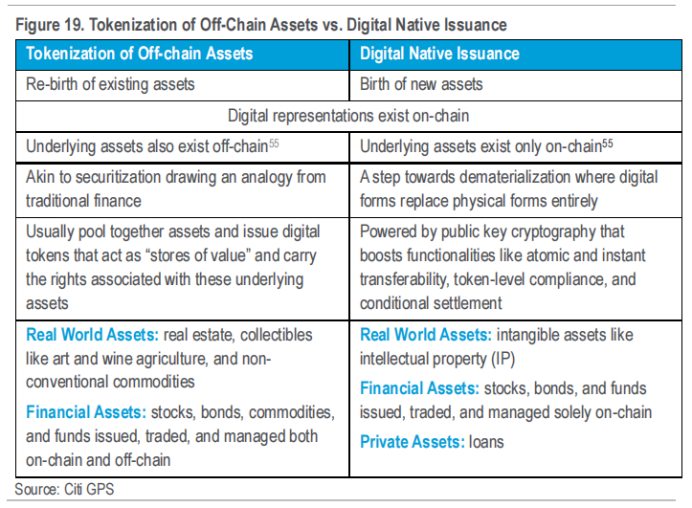
Tokenization can serve as an entry point for real-world assets to enter the Web3 blockchain ecosystem, which can enable capital to transition to the new Web3 ecosystem in an orderly manner, thereby avoiding damage to the existing infrastructure. Currently, various jurisdictions are actively exploring the tokenization process for securities, and the issuance of native security tokens is mainly concentrated on bonds.
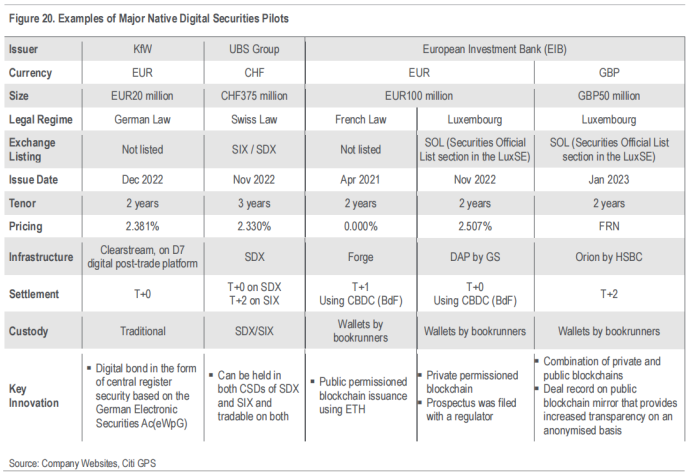
Case 1: Digital Collateral Market
The collateral/securities lending market, or repo market, is a key securities market segment that can immediately benefit from tokenization. Despite the repo market’s monthly trading volume exceeding $2 trillion, the market’s existing trading and post-trading processes are still largely manual and inefficient, with huge risks.
Some new tokenization projects based on distributed ledger technology have emerged to target this large and inefficient market by creating digital collateral records on the blockchain. Once digitized, these assets will enter a single, seamless pool of collateral assets and be able to take advantage of smart contract features such as automation and conditional settlement, greatly improving operational efficiency.
Platforms such as HQLAX, JPMorgan’s Onyx Repo, and Broadridge’s DLT Repo are already processing billions in securities lending volumes and have the potential to scale further. These platforms will bring significant operational and capital savings to the industry. Given the current industry momentum, it seems likely that the digital collateral market will become the first large-scale use case for digital securities.
Case 2: Private Equity Fund Tokenization
Historically, private market funds have been difficult to access for retail investors, with the market limited to large institutional investors and ultra-high net worth individuals. Furthermore, a stated goal of the alternative asset market is to increase allocations to retail investors. This continued under-allocation is driven by high investment minimums, long holding periods, limited liquidity (including a lack of a developed secondary market), a lack of value discovery, complex manual investment processes, and a lack of investor education.
The challenges supporting this continued under-allocation are high investment minimums; long holding periods; limited liquidity, including a lack of developed secondary markets; fragmented asset discovery options; complex manual investment processes; and a lack of investor awareness and education, among others.
Although tokenization is still in its early stages, asset managers are testing the waters by launching tokenized versions of their popular funds.
Private markets investment firm Hamilton Lane has partnered with digital stock exchange ADDX to tokenize a share class of its most popular global private asset fund, reducing the minimum investment threshold from $125,000 or more to $10,000, giving investors the option to trade these token assets on the digital stock exchange.
At the end of 2022, alternative asset manager KKR also tokenized its healthcare fund on the Avalanche blockchain through digital asset company Securitize. At the same time, private equity firm Apollo partnered with fintech company Figure on the Provenance blockchain for its investment management business and launched a new tokenized fund.
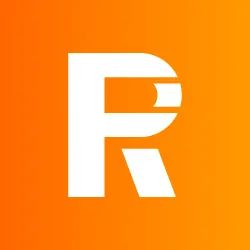 Trade Finance
Trade Finance
Trade finance is a set of technical or financial instruments used to mitigate the risks inherent in international trade, ensuring payment to exporters and delivery of goods and services to importers. Trade finance is a huge market, estimated at $8 trillion by 2022 and potentially growing to $12 trillion by 2030. The World Trade Organization (WTO) estimates that trade finance plays a key role in facilitating and supporting up to 80%-90% of international trade. Legal changes and technological advances could drive the tokenization of up to $1 trillion in global trade finance by 2030.
One of the drivers of change in trade finance is the upcoming legal reform. Almost 80% of global trade is governed by English law, which may soon begin to accept Electronic Transferable Records. The Model Law on Electronic Transferable Records (MLETR) was first introduced by the United Nations Commission on International Trade Law (UNCITRAL) in 2017 and applied by Bahrain, Singapore, Abu Dhabi and other countries in 2021. MLETR applies to electronic transferable records such as bills of exchange, bills of lading, drafts, international guarantees, letters of credit, other receipts, etc. This is a potentially major change with far-reaching implications for the digitization of trade finance.
Until now, in most countries, only paper documents are legally binding under common law. Once documents in electronic form are legally binding, it will greatly improve the speed and security of transmission, allow data reuse, and enable transactions to be automated through smart contracts. Digitizing trade documents is the first step in using digital assets in trade finance. Digital transformation is expected to reduce global international trade costs by 80% and push trade volume to $9 trillion, accounting for about 10% of global GDP. By 2026, legal reforms could bring the total benefits of paperless trade to Commonwealth countries to $1 trillion, and Asian countries are also expected to benefit.
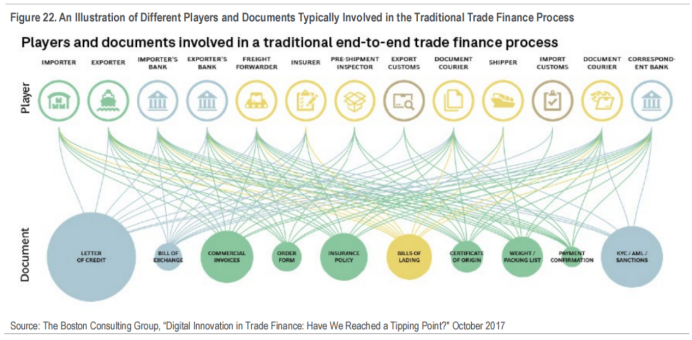
Another driver of change in trade finance is the increase in interoperability. Previously, banks and companies deployed private closed networks, which was the equivalent of some people using SMS, others using WhatsApp, and another using Telegram. But now, there is a growing awareness of the need for networks to communicate with each other - to have a network of networks.
The People’s Bank of China, the Central Bank of the United Arab Emirates, the Bank for International Settlements, the Bank of Thailand, and the Hong Kong Monetary Authority (HKMA) have joined the mCBDC Bridge to facilitate real-time, distributed ledger technology-based cross-border foreign exchange payments. International trade settlements have been selected as the first business use case to be piloted on mBridge. The mCBDC pilot consists of four participating jurisdictions directly on mBridge, which differs in two ways: (1) settlement of international payments occurs directly on a common blockchain platform, rather than on each country’s domestic payment systems, and (2) paying and receiving banks transact directly with each other. The mCBDC pilot aims to demonstrate the capabilities of blockchain networks and central bank digital currencies to increase the speed and efficiency of cross-border payments while reducing costs and settlement risks.
After 2030, we are likely to see wider adoption of blockchain in trade finance, with interoperability enabling tokenization to a higher percentage. Wider adoption will require simpler applications, basic functionality at low or no cost, and new liquidity providers to support trade finance.
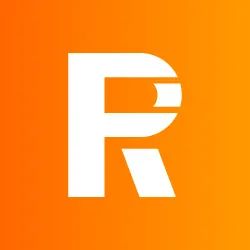 Technology Enablers
Technology Enablers
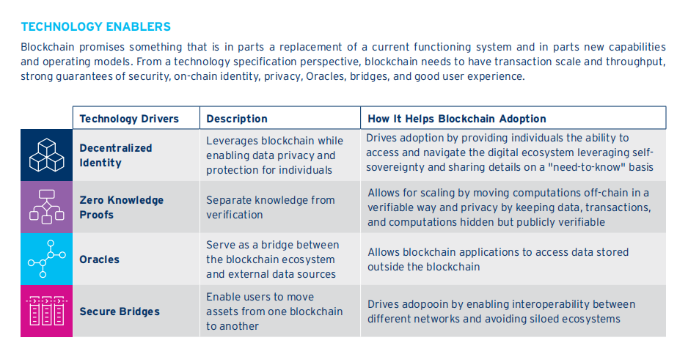
The Internet has brought about the high-speed flow of information and brought 15% of the world's population onto this information highway in 10 years. Blockchain is different from technological innovations such as the Internet, and is more like an institutional innovation. In contrast, blockchain will partially replace the current operating system (at the level of value transfer), but will also simultaneously promote new ideologies (sovereign individuals and decentralization) and provide new capabilities and operating models (digital tokens and on-chain functions). To make matters more complicated, blockchain technology touches the core of the monetary system and legal supervision, and also needs to be compatible with existing infrastructure.
So what needs to be improved on the technical level for Web3 and the blockchain ecosystem to achieve billions of users and a market size of tens of trillions of dollars?
6.1 Decentralized Identity
Web3 digital identity refers to the unique, verifiable and decentralized identity representation of an individual or entity on the blockchain, which digitally proves "who I am". Web3 digital identity solutions are designed to provide individuals and entities with control over their data and the ability to use this data in a secure and trusted manner (such as transactions and interactions).
We have evolved from the simple email paradigm of Web1 digital identity to the only more secure and isolated form of digital identity in the Web2 era (such as Google, Apple, and Facebook all have their own independent account verification systems, and users can only rent space on a separate platform for Read & Write and pay data rent). Now, we are at the cusp of the Web3 era - decentralized on-chain self-sovereign identity. This allows users to own their own identity, and thus own their own digital content and digital assets (Read & Write & Own).
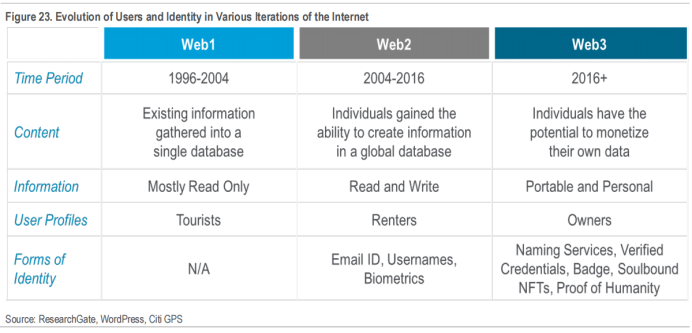
Why do we need decentralized identity? Web3's decentralized identity can transform the mode of large platforms holding data into self-control, and use the decentralized identity system for the entire platform and network. At the same time, this can effectively prevent centralized platforms from using their monopoly position to do evil (whether it is using user data for their own benefit or causing data privacy leakage).
Decentralized identity also introduces a new paradigm whereby some identity information (rather than all) can be shared based on the “need to know” information for different scenarios. It has the potential to minimize the amount of personally identifiable information data (digital footprint) that users leave on the Internet. Decentralized identity is a core technology component of blockchain that will enable blockchain usage to comply with regulatory requirements while still preserving anonymous access.
We believe that decentralized digital identity may be the key to interacting with the Web3 world of decentralized finance, decentralized social, and the open metaverse. A 2022 report by Cheqd estimates that the potential market for decentralized digital identity is about $550 billion. McKinsey estimates that comprehensive decentralized digital identity system coverage in the seven key countries they analyzed alone could add 3%-13% to GDP by 2030.
6.2 Zero-Knowledge Proofs
Zero-knowledge proof (ZKP), in simple terms, is a proof that separates knowledge (information required for verification) from verification. It can fully prove that one is the legal owner of certain rights and interests without leaking relevant information - that is, the "knowledge" given to the outside world is "zero".
In cryptography, this "proof" process is usually done interactively, with the verifier asking the prover a series of questions and the prover answering them. For example, these questions may involve "opening" the solution at a specific location to prove that the solution is correct, but this "proof" does not reveal all information about the entire secret solution, that is, the prover proves to the verifier and makes him believe that he knows or has a certain message, but the proof process cannot reveal any information about the proven message to the verifier. After repeating it enough times, there is a high probability that the prover knows the solution.
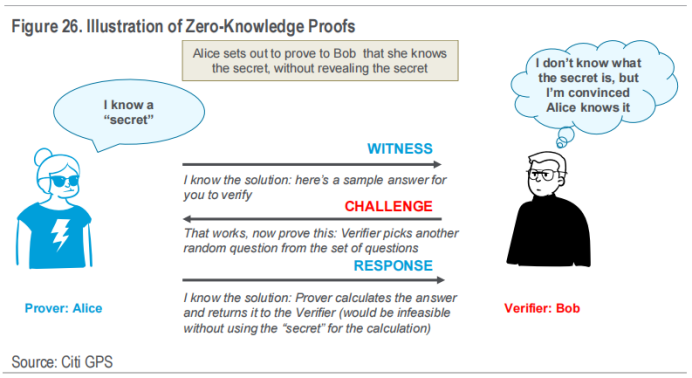
Privacy is a fundamental right and necessity for individuals and institutions. Banks and financial institutions may want to use blockchain for transactions, payments, and various processes, using the technology to improve the efficiency of the middle and back offices. However, the data on the chain is open to anyone and everyone, and anyone can see a private transaction between two customers of a bank. ZKP solves the above privacy issues, and information such as payment amount, delivered goods or services, and payment terms will not be disclosed publicly.
ZKP privacy solutions on public blockchains are critical to driving institutional adoption of blockchain. ZKP provides an elegant solution to “have our cake and eat it too”, leveraging the transparency and public verifiability of blockchain without compromising the confidentiality and privacy of an institution’s proprietary data.
ZK-SNARKS technology addresses two main properties in blockchain: privacy and scalability. Privacy comes from ZKP, where the prover is able to prove a statement to the verifier without revealing the secret. Scalability comes from SNARKS technology, where verifying a statement is orders of magnitude faster than the computation required to run the proof statement.
6.3 Oracles
Blockchains, by design, can only access and process “on-chain” data. Oracle can be thought of as an application programming interface (API) that helps connect blockchains to the real world, connecting on-chain data with off-chain data. Oracle is the core of connecting blockchains to real-world data and information.
Oracle is a prerequisite for scaling blockchains, because without access to real-world asset data, Web3 use cases will be limited to the on-chain ecosystem. Oracle will create a hybrid smart contract consisting of on-chain contract code and off-chain real-world data nodes.
In a typical transaction, the Oracle's on-chain contract code receives data requests from other smart contracts and passes them to the off-chain Oracle node. The Oracle node is then able to obtain and verify external information by querying external databases using APIs in order to collect the requested data. The collected data is then transmitted back to the smart contract using the on-chain contract code.
Currently, we find that most of the work for Oracles is done in the DeFi space. However, we are starting to see regulated financial institutions building many Oracles for market and data pricing. As more assets come on-chain (e.g. bonds, stocks, real-world assets), proof of reserves will be a necessity, and it is expected that Oracles will play a larger role in external financial market data.
6.4 Secure Bridges
The essence of future blockchain is multi-chain, because different blockchains are being built and optimized for different use cases with different design ideas. This leads to the need for interoperability between chains and the emergence of potential solutions such as cross-chain bridges.
A cross-chain bridge is a protocol or intermediary that enables users to transfer on-chain assets from one blockchain to another. Cross-chain bridges are suitable for a wide range of information communications, smart contract calls, and other types of cross-chain communications. This is particularly important in the context of promoting the application of blockchain in traditional financial markets, as information and data need to be transmitted between different institutions or blockchain ecosystems.
One of the common use cases of cross-chain bridges is the Lock and Mint model, in which users can use the tokens of blockchain A on blockchain B. First, the user sends the tokens from blockchain A to the smart contract of the cross-chain bridge and locks them; then, the cross-chain bridge deploys a smart contract on blockchain B, which aims to mint the same number of tokens on blockchain B, which is usually a "wrapped" version of the tokens of blockchain A; finally, the tokens of blockchain B are sent to the user's address, and the user can now use the tokens on blockchain B for consumption, lending, etc.

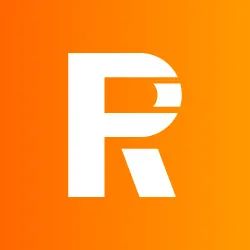 Legal Enablers
Legal Enablers
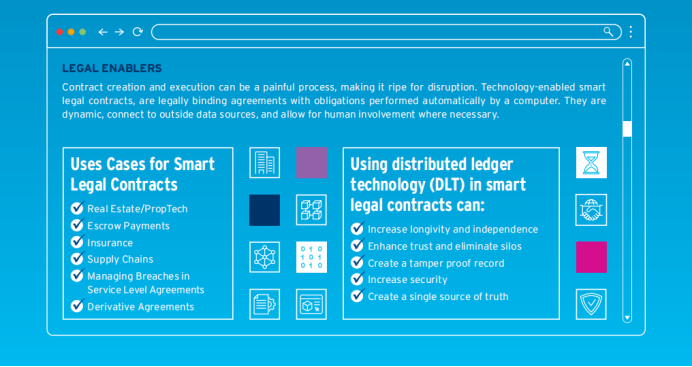
In our daily lives, contracts are everywhere, and each of them establishes a legal relationship between two (or more) parties. We should pay attention to how we perform contracts, because contracts are closely related to both business environments and our personal lives. Although contracts are mature, with the development of technology, contracts will be taken to a new level - Smart Legal Contract (SLC), bringing improvements in automation, efficiency and security.
7.1 Smart Legal Contract (SLC)
The concept of smart contracts has a long history. It is a set of promises expressed in digital form, including agreements for the parties to fulfill other promises. Smart contracts consist of a set of promises, a digital format, and an agreement. According to the Ethereum organization, a "smart contract" is simply a program that runs on the Ethereum blockchain. It is a collection of code (its functions) and data (its status) located at a specific address on the Ethereum blockchain. The organization further explains smart contracts as "computer programs stored on the blockchain that allow traditional contracts to be converted into digital parallels."
For the purposes of our report, we make a distinction: a legal smart contract (SLC) is a type of smart contract, but has different characteristics from smart contracts:
A. SLC may or may not use blockchain – this is in contrast to smart contracts built on blockchain.
B. SLCs are designed to create legally binding agreements that comply with the legal and regulatory requirements of their jurisdiction (in form and structure). Smart contracts rarely consider legal enforceability. As stated by the UK Law Commission, smart contracts can be used to define and perform the obligations of a legally binding contract. The Commission explicitly defines SLCs as: "A legally binding contract in which some or all of the contractual obligations are defined and/or automatically executed by a computer program."
C. As smart contracts lack legal enforceability, the code syntax used in smart contracts is the subject of agreement between the parties - they have no legal enforcement as a fallback. In contrast, SLCs include an agreement on the intent of the parties and how automation will be used to achieve that intent. This allows the court system to get involved in cases of disputes, improper execution, or computer code failures.
D. Smart legal contracts are more adaptable to changing circumstances than smart contracts – to achieve legal compliance, they must contain clauses allowing them to be suspended, amended or corrected.
E. While both smart contracts and SLCs can connect to and use external data sources (called oracles when used in smart contracts), the legal enforceability of SLCs enhances their ability to use human assistance in self-enforcement. Oracles can be used by roles such as auditors, inspectors, or agents to assist in legal matters.
7.2 Classification and characteristics of legal smart contracts
SLCs can be divided into three categories, with varying degrees of automation, applicable to different situations in practice:
(1) The most widely used SLC is a natural language contract combined with code. It uses the code of a computer program to execute contractual obligations (note: the code does not define contractual obligations);
(2) Pure code contracts, where both the contract terms and execution are completed by code, are rare in practice;
(3) Hybrid contracts, where some terms are defined in code and some contractual obligations are enforced by code.
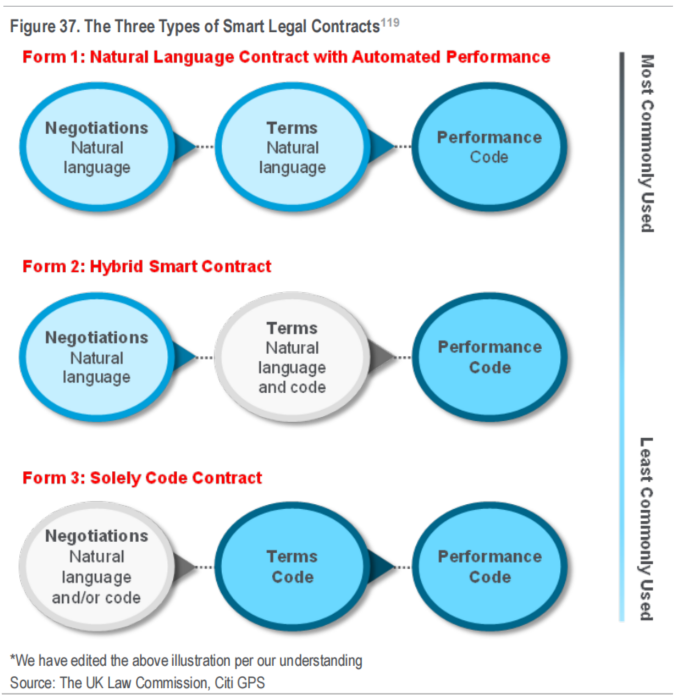
Although SLC looks similar to smart contracts, it has the following characteristics:
A. Payment Identifiers : SLCs can create and embed International Bank Account Numbers (IBANs) or any other identifiers (such as blockchain "public keys" for "on-chain" payments) in the text of contracts, and these identifiers and their terms are managed exclusively by the SLC. This means that payments to the SLC (via the IBAN) will be processed quickly and accurately, and the SLC will verify that payment requirements have been met. For example, a corporate bond based on an SLC will receive interest payments from the borrower and distribute the interest to each bondholder. Payment automation is created through bank integration services, which build a bridge between SLCs and the global banking system.
B. Polls/Questions : The SLC contains polls (or similar functionality). These polls require the parties to the agreement (i.e. the signatories to the agreement or the service providers to the agreement) to answer questions about parts of the contract that cannot be digitized, are often based on subjective assessments or require some form of external activity. This is exactly the part of the SLC that requires human involvement.
This is important because many legal agreements contain clauses that cannot be effectively implemented without human assistance. For example, a contract might require X number of audits per year before payments are sent. So a poll might ask: Have X number of audits been conducted? This requires a human to answer this question, and based on the answer, the next stage of the contract can be executed.
C. The SLC Connects APIs : This allows the SLC to use external data as part of its decision making and is able to record the conditions that were achieved when the SLC was executed. It can also provide data about the SLC, such as its terms or its execution history or status, to external systems via APIs. This is extremely important for businesses with a large portfolio of contracts on their books, where other technologies such as machine learning can be applied to help extract insights and make business decisions. These insights can include how contracts are executed, where contracts fail, where there are disputes, where the business may have concentrate





